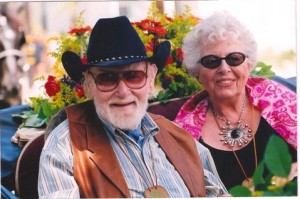
His legs were too short for “ol’ Buck,” he recalls, so he was given a pony to ride. The pony turned out to have a mean disposition, which eventually sent Carey, nicknamed “Dobe” for his dusty red hair, back to gentle Buck. From Buck, other horses, and a small contingent of Navajo ranch hands, Dobe learned riding skills that would undergird his 50-plus years in films and television.
“You can always tell a novice rider; they aren’t comfortable in the saddle and have to hang on,” observes Carey. A modest man who dismisses some of his films as “terrible” and himself as “not a natural athlete,” Dobe nonetheless makes this claim to fame: “I was an expert horseman.”
Roman-style or trick-riding standing on two barebacked horses going at full gallop is a prime example of what he learned to do on short notice for 1950’s Rio Grande, one of the nine movies he made under the direction of John Ford. Carey also performed in other Ford classics, such as 3 Godfathers, The Searchers, and She Wore a Yellow Ribbon.
He and Ford, who was an old family friend, often had a strained relationship on the set. Dobe details this and other adventures in his fascinating 1994 autobiography, Company of Heroes: My Life as an Actor in the John Ford Stock Company.
The son of silent film star Harry Carey Sr. and actress Olive Golden, Dobe is the last survivor of Ford’s famous stock company, which included John Wayne, Ward Bond, Victor McLaglen, Jane Darwell, and Ben Johnson, among others.
At 91, Harry Carey Jr. says it has been at least a decade since he straddled a horse. However, he and his wife, Marilyn, did enjoy riding in a horse-drawn carriage when he was celebrity grand marshal of Santa Barbara’s Old Spanish Days parade in 2004.
They had moved from Colorado to the Goleta foothills to be near their two daughters and grandchildren. A son resides back east. Dobe also has a sister, Cappy, who is a Santa Barbara resident. Now the senior Careys live in an assisted care home just outside of Goleta’s city limits.
The Carey family’s long association with Westerns makes Goleta a particularly appropriate residence for them. For more than a century, the region’s varied scenery made it a favored location for film backdrops, especially Westerns. The connection was celebrated this year during the 100th anniversary of the American Film Manufacturing Co.
Better known as the Flying A, the studio produced a total of more than 900 silent movies between 1912 and 1920 from its Santa Barbara home base at Mission and Chapala streets. More than one-third of these were Westerns, and Allan Dwan, who cofounded the Flying A Studio’s West Coast operation, directed many of them.
Dwan and his small crew of actors, technicians, and livestock wranglers were welcomed warmly by the Santa Barbara Chamber of Commerce, as documented in exhibits at the Historical Museum on East De la Guerra Street. (The exhibition runs through September 16.)
In a July 1912 letter to Dwan, the Chamber extended carte blanche to the Flying A crew, announcing, “Our valleys, canyons, sea shore and heights are hereby declared proper targets for your camera … ”
Last month the University of California Santa Barbara took note of the centennial by screening fragments of early silent films, mostly from the Flying A, at its new Pollock Theater. The audience also heard historian Neal Graffy and studio professor Dana Driskel sketch the studio’s impact on the community and honor pioneer filmmakers like Dwan.
Allan Dwan left the Flying A to relocate in a booming Hollywood where a critical mass of production companies was forming. Due to Dwan’s longevity and versatility, he worked there another half-century and even directed young Dobe Carey in at least five films in the early 1950s. Most of these were Westerns.
“I loved Allan Dwan,” Carey recalls, adding with a smile, “He was a tough old guy.” High compliments from one tough old survivor to the memory of another.
